Dog hot spots are a fairly common skin condition that can look alarming and show up seemingly out of nowhere. To help you know what to expect if a hot spot pops up on your dog, integrative veterinarian Dr. Julie Buzby discusses the causes, symptoms, diagnosis, treatment, and prevention of hot spots.

Recently, I got a somewhat panicked text from my neighbor. “I just got home from work and Clarabelle has a huge sore on the side of her face! I swear she was totally fine this morning! Help! What do I do?” Accompanying the text was a picture of sweet Clarabelle, who did indeed have a nasty-looking weeping area on the side of her otherwise adorable Goldendoodle face.
Even without the picture, I would have had a pretty good idea of what was wrong from the description alone. But the picture sealed the deal.
I wrote back to her “Aww, poor girl! Looks like a hot spot. Call the clinic in the morning to set up an appointment and we will get her taken care of. In the meantime, you can clean up the area with mild soap and water and put a bit of hydrocortisone cream on it.”
Relieved, my neighbor thanked me for helping put her mind at ease. And she assured me she would save the rest of her hot spot questions for the appointment.
You may have some of the same questions she did. If so, this article is for you!
What are hot spots on dogs?
A hot spot is a distinct red, itchy, and sometimes moist or ulcerated area on a dog’s skin. It also goes by the name moist eczema, pyotraumatic dermatitis, or acute moist dermatitis. These skin problems often seem to come up out of nowhere. However, there are actually some identifiable reasons why dogs get hot spots.
What causes hot spots on dogs?
Hot spots stem from something that triggers a dog to scratch, lick, chew, or otherwise traumatize the skin in a particular location. It may start off with just a small itch or irritation. But soon the dog gets caught in a vicious itch-scratch cycle. Itching or licking releases endorphins, which temporarily makes the dog feel better. This leads to more itching and scratching, and the cycle continues.
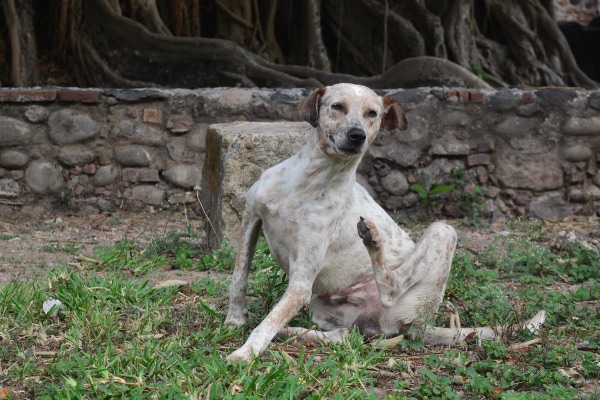
As a result of the continued trauma, the surface of the skin becomes profoundly inflamed. Sometimes bacteria such as Staphylococci spp may colonize the broken skin. However, a hot spot isn’t truly a bacterial skin infection. It is skin inflammation that is sometimes accompanied by secondary bacterial growth.
Dog hot spot causes
The cause of a dog’s hot spot can be any of the following:
- Insect bites (fleas, mosquitoes, etc.)
- Parasitic skin diseases (e.g. demodicosis and scabies)
- Allergies—seasonal allergies (i.e. atopic dermatitis), food allergies (i.e. cutaneous adverse food reaction), and flea allergies (i.e. flea allergy dermatitis) can all cause a hot spot
- Ear infections (i.e. otitis in dogs)—scratching at the affected ear may create an area of skin trauma on the dog’s face
- Irritation of the skin from plant material (e.g. foxtails in dogs), dirt, or foreign bodies
- An area of matted fur or dirty fur (poor grooming)
- Contact sensitivities (i.e. reaction to a substance the skin comes into contact with)
- Pain from dog anal gland issues, dental disease in dogs, muscle injuries, osteoarthritis in dogs, or other uncomfortable medical problems
- Excessive and repetitive licking of an area of the body due to anxiety, boredom, or psychological stress (which may also create a lick granuloma in dogs)
- Excessive moisture from frequent swimming or other causes of trapped moisture
- Wearing a wet or tight-fitting collar
Predisposing factors
Based on this list of causes it makes sense that hot spots in dogs can happen at any time of the year. However, they seem to occur most often when the climate is hot and humid.
While any dog breed can develop a hot spot, breeds with thicker hair coats are overrepresented. The most common breeds that develop hot spots are:
- Labrador Retrievers
- Golden Retrievers
- German Shepherd dogs
- Saint Bernards
- Collies
- Spaniels
What does a hot spot look like on a dog?
The dense haircoat of these breeds also does a good job of hiding the hot spot at first. As a result, a dog parent may not know anything is wrong until the skin is intensely red, moist, and covered by matted or crusted fur, as shown by the photo below. These hot spots can look like an open wound and are often very painful.
On the other hand, it is easier for a dog parent to notice a mild hot spot on dogs with thinner fur. Typically, there is a faint red appearance to the skin and the dog might have some hair loss. These areas are usually flat, dry, and non-flaky.
As you can tell from these descriptions, hot spots can look quite different depending on how severe they are. The pictures of hot spots on dogs throughout this article might help you to identify them more easily.
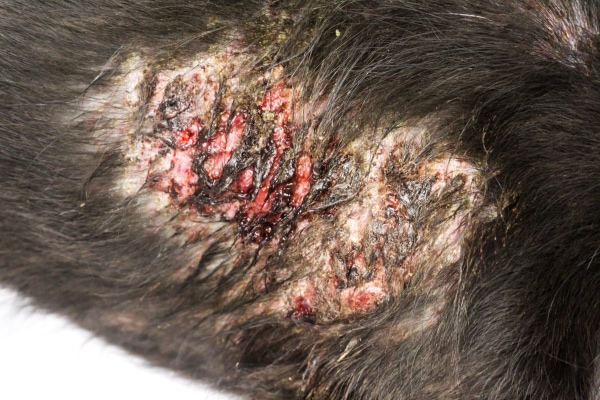
Where are hot spots located on a dog’s body?
There is quite a bit of variation in where a hot spot may occur on a dog’s body. The most common sites for hot spots are the ears, head, tail base, and around the anus. However, you can also see hot spots on a dog’s legs, neck, paw, belly or other locations. In fact, hot spots can occur anywhere on a dog’s body that he or she can lick, chew, rub, and scratch.
Since dogs tend to focus their attention on areas that are bothering them, the location of the hot spot can sometimes give clues about the identity of the underlying problem. For example, moist dermatitis near a dog’s tail may suggest a sensitivity to flea bites. Along the same lines, ear infections are notorious for contributing to facial hot spots. And anal gland infections and contact allergies are often responsible for hot spots over the perineal area (i.e. skin between the anus and vulva or scrotum).
If you notice any skin irritation in these areas, it is best to consult with your vet. The sooner you can start treatment, the better.
How is a hot spot diagnosed?
Since hot spots tend to have a fairly classic appearance, your vet may not need to do any diagnostic testing other than the physical exam. However, in some cases your vet may recommend additional testing such as:
- Skin cytology—this involves collecting cells and material from the surface of the lesion and examining them under the microscope.
- Skin biopsy—sampling a small portion of the skin and examining it under the microscope can help rule out other conditions like tumors or furunculosis in dogs.
- Ear cytology, orthopedic exam, oral exam, dog anal gland palpation, or other tests that help pin down the inciting factor for the hot spot.
As part of the diagnostic process (and also the treatment), the veterinarian will probably start by clipping the hair in the affected area. This allows the vet to see the full extent of the hot spot. Plus, it will help improve air flow and access to the skin, both of which are important for treatment. Otherwise, as you can see in the picture of a hot spot below, the hair could get in the way.
Since hot spots can be painful, some dogs may require short-acting sedation to allow safe and comfortable clipping.
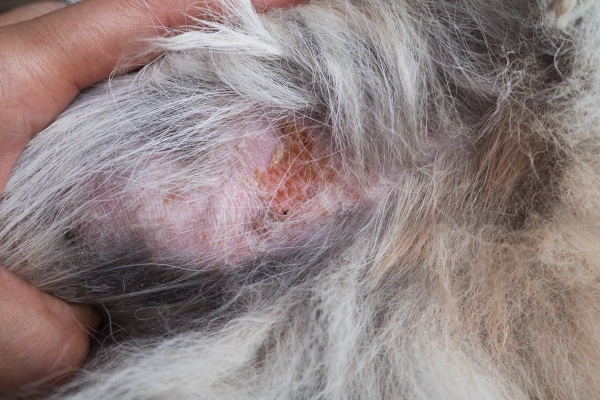
What is the treatment for a hot spot?
After clipping and evaluating the hot spot, your veterinarian will discuss the best hot spot treatment for your dog. For most dogs, this primarily involves topical treatment. However, occasionally dogs may benefit from systemic medications.
Cleaning and drying agents
The vet may start by cleaning the hot spot with an antimicrobial agent like dilute chlorhexidine or a diluted povidone-iodine solution. Or they may choose an astringent like Domeboro, which can do a good job drying up moist or oozing skin lesions.
Steroids
Topical corticosteroids also have their advantages as part of a hot spot treatment plan. They are anti-inflammatory and help to decrease the pain and itchiness. Your vet may prescribe a steroid-containing topical powder or a hot spot spray to put on the hot spot. Occasionally, a dog may also need oral steroids like prednisone for dogs to calm down severe inflammation and pain.
Antihistamines
Sometimes giving your dog an over-the-counter antihistamine can help calm down mild itching. Benadryl for dogs is a popular choice. It is generally safe and comes as a topical ointment or an oral liquid or pill. However, it is best to consult with your vet before giving your dog an antihistamine so he or she can help you figure out the correct dose and ensure it is a good choice for your dog.
Antibiotics
Not every hot spot case will require antibiotics. However, if skin cytology confirmed the presence of a bacterial skin infection (i.e. pyoderma in dogs), or if your pup has severe pyotraumatic dermatitis, your vet might prescribe an oral antibiotic. Alternatively, the vet might recommend a topical product such as animax ointment that contains an antibiotic and a steroid.
E-collar or shirt
In order to break the itch-scratch cycle and promote healing, it is vital to ensure your dog cannot further traumatize the hot spot. You will likely need to purchase an Elizabethan collar (i.e. E-collar or “cone of shame”) to keep your dog from licking the area. Or, if your dog is using the back paws to scratch the site instead, a commercial doggy bodysuit, baby onsie, or even a loose-fitting T-shirt can be a good way to protect the hot spot as it heals.
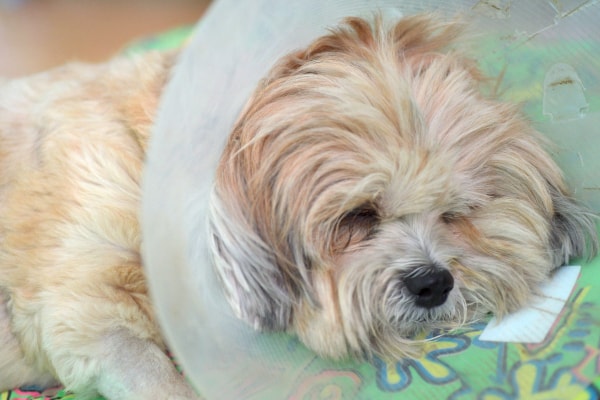
Treatment for the underlying condition
Last but certainly not least, it is important to address the reason that the dog developed a hot spot in the first place. This may involve:
- Ear medications for dogs with otitis
- Allergy medicine for dogs (e.g. Apoquel, Cytopoint, etc) to help control seasonal allergies
- Limited ingredient or hypoallergenic diet for dogs with food allergies
- Routine foot or belly wiping for dogs with contact allergies
- Pain medications or natural pain relief for dogs if the hot spot is a sign your dog is in pain
- Flea control for flea-allergic dogs
Are there home remedies for hot spots on dogs?
While seeing the vet is often the best plan, there may be situations where it will be a few days before you can get into the vet. In those cases, temporary hot spot relief for dogs can come from items that you might have in your home.
If you can identify the hot spot early (before it intensifies), placing an E-collar or cone on your dog is one of the quickest fixes. It will hopefully stop him or her from licking or further traumatizing the area.
It can also be helpful to clean the hot spot with mild soap and water. Alternatively, you might be able to use some antimicrobial cleansers or astringents like witch hazel from your own medicine cabinet.
However, do not reach for isopropyl alcohol, hydrogen peroxide, Listerine, or apple cider vinegar as these tend to be irritating to the dog’s skin.
If you are comfortable, you can use special clippers to clip the fur away from the hot spot yourself. This will ensure that it can dry up and heal well. You can wear gloves during this step if you want. But the good news is that hot spots typically aren’t contagious to you or other dogs.
If your pup protests the clipping and cleaning, it is best to skip these steps. Hot spots can be very painful, especially when they are severe.
Products to put on the hot spot at home
Additionally, there are topical anti-itch products made for treating hot spots on dogs which may provide temporary relief. Topical hydrocortisone cream or topical Neosporin ointment (i.e. triple antibiotic ointment) are often safe to use in small amounts. However, try to ensure that your dog does not lick them off. If you don’t have an E-collar to put on your dog, it may be helpful to distract your dog with a walk, mental stimulation toys for dogs, or some attention after applying the cream or ointment.
Also, you can use any number of anti-itch hot spot shampoos for dogs. And oatmeal baths can be very effective for more generalized itchy skin.
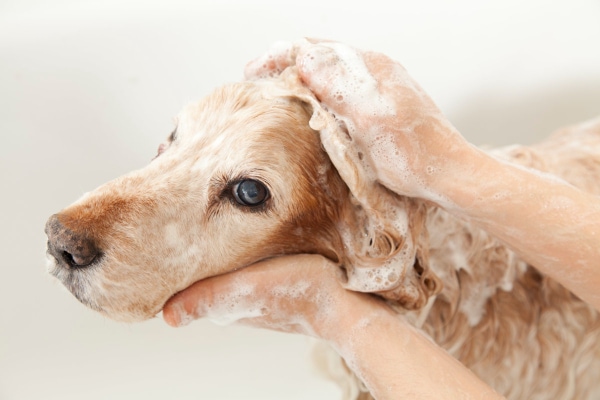
Products to avoid using for a hot spot
If you are googling home remedies for dog hot spots, you many also come across some things that are not actually a good idea.
For example, Bag balm, Aquaphor, Vaseline, or other moisturizing agents are NOT recommended because they can make a hot spot worse by trapping moisture in the area. Also, stay away from Gold Bond powder, Pepto-Bismol for dogs, essential oils, diaper rash cream (zinc oxide), and athlete’s foot cream (miconazole). These products may worsen a dog’s hot spot, simply not work at all, or be dangerous if ingested in high enough quantities.
Natural remedies for hot spots
Some other tried – but not necessarily scientifically proven – natural remedies include:
- Applying moist tea bags directly to the irritated skin
- Coconut oil
- Aloe vera— the aloe vera plant itself is toxic for dogs, so it is important to ensure any aloe vera-containing products are formulated for dogs and approved by your vet
- Omega-3 fatty acids for dogs—but remember that seeing the anti-inflammatory and skin-support benefits may take several weeks
- Calming supplements—may be helpful for anxious dogs who lick themselves a lot
Natural remedies or home remedies for hot spots on dogs can be effective, especially if the hot spot is mild. But if your dog has moderate to severe hot spots, a home remedy might not provide much relief. Still, they are worth keeping in mind because even a little relief is better than nothing while waiting to be seen by your veterinarian.
What are the hot spot healing stages?
After starting treatment, you should expect most dog hot spots to improve rapidly over about three to seven days. For more severe hot spots on dogs, it may take about one week for the skin lesion to dry up and look more like a scab. Then it may be about two weeks before you would begin to see hair regrowth. By three to four weeks out, the majority of hot spots have fully healed.
During this time, particularly if your canine companion is on systemic antibiotics, following up with your veterinarian is extremely important. Like with all bacterial infections, treatment with a systemic antibiotic should continue several days beyond the resolution of clinical signs. This is to ensure that the hot spot is fully healed and does not become a breeding ground for resistant strains of bacteria in future. Plus, it helps keep the hotspot from quickly reoccurring it if wasn’t fully healed.
What to do if your dog’s hot spot is not healing
If at any point you think your dog’s hot spot is not healing well or it seems to be getting worse, please reach out to your veterinarian. Your dog might need a different antibiotic (or different form of an antibiotic), stronger anti-itch medications, different treatments for the underlying condition, or other modifications to the treatment plan. Or your vet may want to perform additional diagnostics to help get to the bottom of the problem.
How can you prevent hot spots?
As you can see, there are many treatment options for hot spots, and healing is usually fairly rapid. But hot spots can be quite painful for your dog, so it makes sense to want to prevent them from forming if possible. Some tips for preventing hot spots on dogs include:
- Focus on preventive care such as keeping your dog current on his or her flea prevention.
- Routinely bathe your dog and learn how to clean your dog’s ears.
- Avoid mats by frequently grooming dogs with thick fur or long hair.
- Have your vet routinely express your dog’s anal glands IF they fill up quickly or are prone to impaction.
- Work with your vet to create an allergy management plan for your dog to reduce itching.
- Clean your dog’s ears and ensure his or her hair coat and skin folds are completely dry after swimming.
- Ask your vet about anti-anxiety medications or environmental enrichment (i.e. puzzle toys, chew toys, longer walks) for dogs who are prone to licking themselves excessively due to boredom or anxiety.
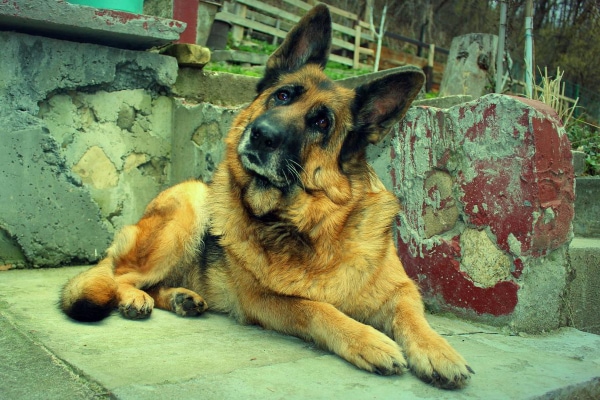
Back to my canine patient, Clarabelle
As it turned out, Clarabelle had a bacterial ear infection that was causing her to scratch her ear. The resulting trauma to the side of her face lead to the hotspot. I clipped and cleaned the hot spot, cleaned her ears, and sent her out the door with ear medication, a topical steroid spray, and the dreaded E-collar. A few days later, my neighbor stopped over to say that the hot spot was healing up wonderfully.
Hot spots—here and gone before you know it
Hot spots can come up quickly, look nasty, and be pretty uncomfortable for dogs. Thankfully though, they usually resolve quickly with appropriate treatment. If your dog has a suspicious spot on his or her skin that you think could be a hot spot, make an appointment with your vet. Then in the meantime, you can consider trying out a safe home remedy. Also, if possible, use an E-collar or T-shirt to keep your dog away from the area.
At the appointment, your vet can formulate a treatment plan for your dog’s hot spot. Plus, he or she can work with you to address the underlying issues and hopefully prevent future hot spots. With some TLC from you and help from your vet, your dog’s hot spot can soon become a distant memory.
Has your dog ever had a hot spot?
Please share your experience below.


our labradoodle has terrible hot spots all over been on medicine for over 3 months for ear infection just doesn’t heal they say bacteria infection n allergies apoquel didn’t work at all help ears are so red n sore she whines when you touch them
Hi Diane,
I am sorry your pup is experiencing ongoing issues with hot spots and allergies. These problems can be difficult to control especially if a definitive cause has not been identified. It may be time to consider asking about a referral to a veterinary dermatologist. Also, I have had good success with using topical products along with oral antibiotics and anti-inflammatories. I particularly like the products from Douxo. Here is a link to their website in case you wanted to take a look: https://www.douxo.com/us
I am hopeful you can find a way to offer your sweet girl relief and restore her quality of life. Wishing you both the best of luck!
My black lab has hairless patches all over. She also has dandruff, and the hotspots are not oozing. She had steroids and antibiotics that seemed to help for a while, then the scratching resumed. Also, her eyes are weeping. Next time I had her at the vet, she had a injection of apoquel. Which also helped. temporarily. There is dog hair everywhere and she is scratching again. Help!!
Hi Lisa,
I am sorry you are dealing with this frustrating situation with your Lab. It sounds like she is experiencing chronic allergy symptoms and is having flare ups frequently. It may be time to schedule a consultation with a veterinary dermatologist. To keep things under control, you will need to either narrow down what is causing the allergies/inflammation or figure out a treatment regimen that can be used daily or at least on a routine basis. Hoping you can find the answers you need to keep your girl feeling her best. Wishing you the best of luck as you navigate this tricky path.
Have hotspots been known to be fatal?
Hi Carla,
This is a great question! “Hot spots” are a term we use when referring to a patch of itchy, red, or infected skin. While the affected patch of skin is not able to cause a fatality, it is possible for the underlying issue to lead to tragic consequences. For instance, if the hot spot is caused by a bacterial infection and the bacteria makes its way into the blood stream, this could lead to sepsis and be fatal. If the hot spot is a symptom of some type of systemic illness or organ dysfunction, the underlying diagnosis may have a fatal outcome. But, no, a hot spot itself should not be able to cause the death of a dog. Hope this clears things up a bit!
My Shih Tzu Yorkie has a very bad hot spot that’s oozing with a reddish fluid and has gotten bigger. I have ointment from the vet and I am going to give him a warm bath to clean the area. Is this a good idea? Can a hot spot be fatal?
Hi Carla,
I am sorry your little pup is dealing with this severe skin problem. Without being able to examine him myself, it is hard to offer advice on how to administer treatment at home. Bathing can be a good idea for some skin conditions but often a medicated shampoo is recommended. I would strongly encourage you to ask your vet before bathing your boy, as excessive moisture from a bath can cause some skin issues to worsen. Also, I just responded to your other comment asking about the risk of a fatality from hot spots. The short answer is no, but please see the other reply for more details. Hoping you can get the answers you need to find a clear path forward. Best wishes and good luck!
I am an adult physician and have an unusual dog (rescue) who is a pedigree Tornjak. I have had dogs with hot spots before, and the most aggravating thing about them is the recurrences, notwithstanding the huge number of side effects with steroids, especially urinary frequency. My current dog had a hot spot two years ago and was given a JAK 2 inhibitor, ocalitinib (sp?). I was staggered by the response which not only was side effect free but durable (no recurrences). Your literature clearly supports its use. Why is it not mentioned here?
Hi Michael,
Thank you for sharing your experience with our readers. I am glad the oclacitinib worked so well for your dog and helped speed up the healing process. The brand name for this medication is Apoquel (JAK1 & JAK3 inhibitor) and is mentioned in the article under the paragraph titled “Treatment for the underlying condition”. I have seen Apoquel do great things for my patients and want to make sure others know about its potential benefits as well. Best wishes to you and your pup!